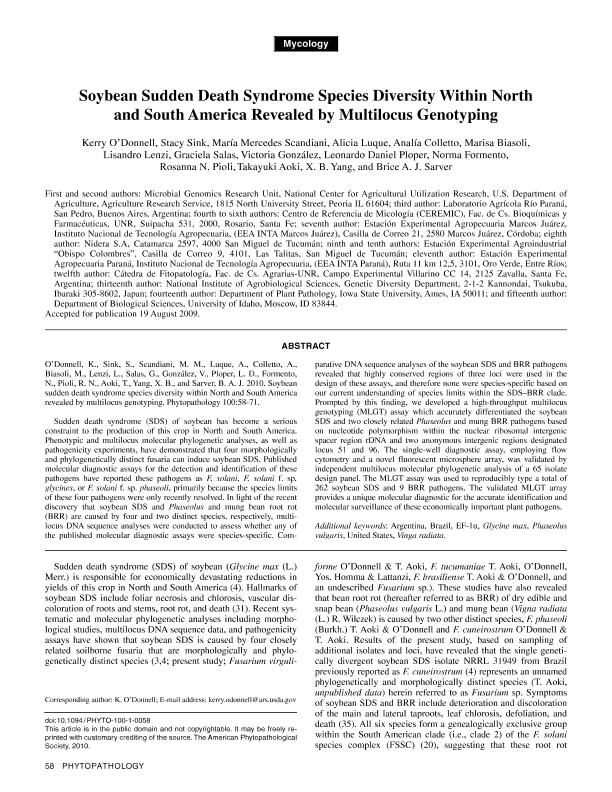Artículo
Soybean sudden death syndrome species diversity within North and South America revealed by multilocus genotyping
O'Donnell, Kerry; Sink, Stacy; Scandiani, María Mercedes; Luque, Alicia; Colletto, Analía; Biasoli, Marisa; Lenzi, Lisandro; Salas, Graciela; González, Victoria; Ploper, Leonardo Daniel ; Formento, Norma; Pioli, Rosanna Nora; Aoki, Takayuki; Yang, X. B.; Sarver, Brice A. J.
; Formento, Norma; Pioli, Rosanna Nora; Aoki, Takayuki; Yang, X. B.; Sarver, Brice A. J.
 ; Formento, Norma; Pioli, Rosanna Nora; Aoki, Takayuki; Yang, X. B.; Sarver, Brice A. J.
; Formento, Norma; Pioli, Rosanna Nora; Aoki, Takayuki; Yang, X. B.; Sarver, Brice A. J.
Fecha de publicación:
01/2010
Editorial:
American Phytopathological Society
Revista:
Phytopathology
ISSN:
0031-949X
e-ISSN:
1943-7684
Idioma:
Inglés
Tipo de recurso:
Artículo publicado
Clasificación temática:
Resumen
Sudden death syndrome (SDS) of soybean has become a serious constraint to the production of this crop in North and South America. Phenotypic and multilocus molecular phylogenetic analyses, as well as pathogenicity experiments, have demonstrated that four morphologically and phylogenetically distinct fusaria can induce soybean SDS. Published molecular diagnostic assays for the detection and identification of these pathogens have reported these pathogens as F. solani, F. solani f. sp. glycines, or F. solani f. sp. phaseoli, primarily because the species limits of these four pathogens were only recently resolved. In light of the recent discovery that soybean SDS and Phaseolus and mung bean root rot (BRR) are caused by four and two distinct species, respectively, multilocus DNA sequence analyses were conducted to assess whether any of the published molecular diagnostic assays were species-specific. Comparative DNA sequence analyses of the soybean SDS and BRR pathogens revealed that highly conserved regions of three loci were used in the design of these assays, and therefore none were species-specific based on our current understanding of species limits within the SDS-BRR clade. Prompted by this finding, we developed a high-throughput multilocus genotyping (MLGT) assay which accurately differentiated the soybean SDS and two closely related Phaseolus and mung BRR pathogens based on nucleotide polymorphism within the nuclear ribosomal intergenic spacer region rDNA and two anonymous intergenic regions designated locus 51 and 96. The single-well diagnostic assay, employing flow cytometry and a novel fluorescent microsphere array, was validated by independent multilocus molecular phylogenetic analysis of a 65 isolate design panel. The MLGT assay was used to reproducibly type a total of 262 soybean SDS and 9 BRR pathogens. The validated MLGT array provides a unique molecular diagnostic for the accurate identification and molecular surveillance of these economically important plant pathogens.
Palabras clave:
Argentina
,
Brazil
,
Ef-1α
,
Glycine Max
,
Phaseolus Vulgaris
,
United States
,
Vinga Radiata
Archivos asociados
Licencia
Identificadores
Colecciones
Articulos(CCT - NOA SUR)
Articulos de CTRO.CIENTIFICO TECNOL.CONICET - NOA SUR
Articulos de CTRO.CIENTIFICO TECNOL.CONICET - NOA SUR
Citación
O'Donnell, Kerry; Sink, Stacy; Scandiani, María Mercedes; Luque, Alicia; Colletto, Analía; et al.; Soybean sudden death syndrome species diversity within North and South America revealed by multilocus genotyping; American Phytopathological Society; Phytopathology; 100; 1; 1-2010; 58-71
Compartir
Altmétricas



